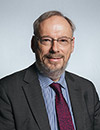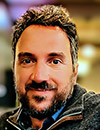Plenary Event
Wednesday Plenary Session
9 April 2025 • 13:30 - 15:10 CEST | Nadir
Joint Plenary Session with SPIE Optics + Optoelectronics
Welcome & Introduction
Saša Bajt, Deutsches Elektronen-Synchrotron (Germany)
Optics + Optoelectronics Symposium Chair
13:35 to 14:20
High repetition rate femtosecond X-ray studies of dynamically compressed matter

Justin S. Wark
Clarendon Lab., Univ. of Oxford and Oxford Centre for High Energy Density Science (United Kingdom)
The use of x-ray diffraction to study materials under rapid dynamic compression has a long history, going back well over half a century. The last two decades have seen particularly spectacular advances, with high power optical nanosecond lasers and other drivers coupled to synchrotrons and x-ray free electron lasers (FELs), such that single-shot diffraction patterns from shocked and ramp-compressed samples can now be obtained on a timescale shorter than the period of even the fastest phonon in the system. In principle this can allow the study of matter in regimes of pressure and temperature inaccessible by almost any other means, and of direct relevance to the structure of planets in our own solar system and beyond.
Experiments using such systems have started to lead to important advances in our understanding of phase transformations and plasticity at the lattice level. One major obstacle to date has been the low repetition rate of the optical lasers (that typically have drive energies of 100’s of joules in nanosecond pulses) compared with the x-ray sources. For example, at the FEL at LCLS the optical laser fires once every 3 minutes, whilst the x-ray pulses even from the warm linac are produced at 120 Hz. Coupling a higher repetition rate optical laser to the x-ray source would not only increases the overall throughput of experiments and acquisition of data, but will open up novel opportunities for photon-hungry experiments, such as spectrally resolving the inelastic x-rays scattered from phonons, or the use of resonant inelastic x-ray scattering (RIXS) which can provide information on the electronic structure of these transiently compressed materials. Early last year the first user experiments were performed that combined x-ray pulses from the European XFEL with the DiPOLE-100X optical laser, which in principle can operate at 10 Hz, thus transforming the landscape for research in this area. Representative and preliminary results from these experiments will be presented.
Justin Wark, received his undergraduate degree in Physics from the University of Oxford in 1982, and his Ph.D. in Plasma physics from Imperial College, London in 1985. He then spent two years as a Postdoctoral Research Assistant at the Laboratory of Laser Energetics at the University of Rochester, a time during which he undertook the very first experiments combining laser shock-compression with sub-nanosecond x-ray diffraction. After returning to the UK he was awarded a Royal Society University Research Fellowship at the University of Oxford, where he set up a research group working in high power laser-matter interactions, and has been ever since.
14:20 to 14:25
Welcome & Introduction
Pavel Peterka, Institute of Photonics and Electronics, Czech Academy of Sciences (Czech Republic)
2025 WSOF Chair
14:25 to 15:10
One (hollow) fibre to rule them all

Francesco Poletti
Optoelectronics Research Ctr., Univ. of Southampton (United Kingdom)
Discovered by accident and for many years only used in a handful of physicists’ labs, antiresonant hollow core fibers have recently astonished the world with their exceptional optical performance, holding promise for transformative applications in optical communications, laser delivery, quantum technology, and beyond. The technology is now ready for mainstream adoption.
Prof. Francesco Poletti is a Hollow Core Fibre (HCF) technology pioneer. He leads the HCF team at the ORC, University of Southampton, and research on HCFs for optical communications at Microsoft Azure FIber. His research on special/hollow-core fibers has produced over 500 publications, 50 invited talks and 20 patents. His spinoff Lumenisity was acquired by Microsoft Azure in 2022 and it now produces hollow core cables for low latency data interconnections.
13:30 to 13:35
Welcome & Introduction
Saša Bajt, Deutsches Elektronen-Synchrotron (Germany)
Optics + Optoelectronics Symposium Chair
13:35 to 14:20
High repetition rate femtosecond X-ray studies of dynamically compressed matter

Justin S. Wark
Clarendon Lab., Univ. of Oxford and Oxford Centre for High Energy Density Science (United Kingdom)
The use of x-ray diffraction to study materials under rapid dynamic compression has a long history, going back well over half a century. The last two decades have seen particularly spectacular advances, with high power optical nanosecond lasers and other drivers coupled to synchrotrons and x-ray free electron lasers (FELs), such that single-shot diffraction patterns from shocked and ramp-compressed samples can now be obtained on a timescale shorter than the period of even the fastest phonon in the system. In principle this can allow the study of matter in regimes of pressure and temperature inaccessible by almost any other means, and of direct relevance to the structure of planets in our own solar system and beyond.
Experiments using such systems have started to lead to important advances in our understanding of phase transformations and plasticity at the lattice level. One major obstacle to date has been the low repetition rate of the optical lasers (that typically have drive energies of 100’s of joules in nanosecond pulses) compared with the x-ray sources. For example, at the FEL at LCLS the optical laser fires once every 3 minutes, whilst the x-ray pulses even from the warm linac are produced at 120 Hz. Coupling a higher repetition rate optical laser to the x-ray source would not only increases the overall throughput of experiments and acquisition of data, but will open up novel opportunities for photon-hungry experiments, such as spectrally resolving the inelastic x-rays scattered from phonons, or the use of resonant inelastic x-ray scattering (RIXS) which can provide information on the electronic structure of these transiently compressed materials. Early last year the first user experiments were performed that combined x-ray pulses from the European XFEL with the DiPOLE-100X optical laser, which in principle can operate at 10 Hz, thus transforming the landscape for research in this area. Representative and preliminary results from these experiments will be presented.
Justin Wark, received his undergraduate degree in Physics from the University of Oxford in 1982, and his Ph.D. in Plasma physics from Imperial College, London in 1985. He then spent two years as a Postdoctoral Research Assistant at the Laboratory of Laser Energetics at the University of Rochester, a time during which he undertook the very first experiments combining laser shock-compression with sub-nanosecond x-ray diffraction. After returning to the UK he was awarded a Royal Society University Research Fellowship at the University of Oxford, where he set up a research group working in high power laser-matter interactions, and has been ever since.
His research interests include high harmonic generation, XUV lasers, x-ray spectroscopy, inertial confinement fusion, and the development and use of novel x-ray sources in studying dynamic compression of solid-state matter via x-ray diffraction. His research group has been highly active in exploiting XUV and X-Ray Free Electron Lasers which have a spectral brightness over a billion times greater than those of any synchrotron, and he has used such sources to both create and diagnose matter under extremes of density, temperature, and pressure.
Justin Wark is currently Fellow, Tutor and Professor in Physics at Trinity College, Oxford, and Director of the Oxford Centre for High Energy Density Science (OxCHEDS).
14:20 to 14:25
Welcome & Introduction
Pavel Peterka, Institute of Photonics and Electronics, Czech Academy of Sciences (Czech Republic)
2025 WSOF Chair
14:25 to 15:10
One (hollow) fibre to rule them all

Francesco Poletti
Optoelectronics Research Ctr., Univ. of Southampton (United Kingdom)
Discovered by accident and for many years only used in a handful of physicists’ labs, antiresonant hollow core fibers have recently astonished the world with their exceptional optical performance, holding promise for transformative applications in optical communications, laser delivery, quantum technology, and beyond. The technology is now ready for mainstream adoption.
In this review, we will explore the breakthroughs that have made these fibers so appealing, including the pivotal discoveries and innovations that have driven their development. We will delve into their unique optical properties, such as their ability to confine light within a hollow core and minimize loss, temperature sensitivity and chromatic dispersion, which make them exceptionally suited for numerous high-performance applications. We will finally examine the scientific and industrial applications poised for short-term and long-term transformation through the use of hollow core fibers.
Prof. Francesco Poletti is a Hollow Core Fibre (HCF) technology pioneer. He leads the HCF team at the ORC, University of Southampton, and research on HCFs for optical communications at Microsoft Azure FIber. His research on special/hollow-core fibers has produced over 500 publications, 50 invited talks and 20 patents. His spinoff Lumenisity was acquired by Microsoft Azure in 2022 and it now produces hollow core cables for low latency data interconnections.
